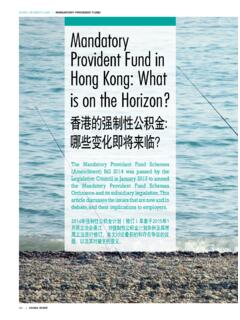Transcription of Telehealth around the world: A global guide
1 NOVEMBER 2020 Telehealth around the world : a global Telehealth around THE world : a global GUIDE2 IntroductionThe COVID-19 pandemic has caused healthcare systems around the globe to rapidly, and in some cases, radically rethink the delivery of medical care. The global expansion of Telehealth services is one way we have seen this transformation occur. This has resulted in significant opportunities in the field, as well as unprecedented regulatory a quickly evolving area, Telehealth can have different meanings in different contexts. In this global guide , Telehealth refers to the delivery of healthcare services where patients and providers are separated by distance, using information and communications technology for the exchange of information for the diagnosis or treatment of diseases and injuries. We have adapted this definition from the world Health Organisation s definition of is not a new concept healthcare providers, academics and technology developers have been advocating for its use for decades.
2 There are many benefits to the widespread adoption of Telehealth , including improved access to healthcare services, risk mitigation, convenience and flexibility, and in many cases, a reduction in overhead costs. However, the use of Telehealth is not without its challenges. For example, it is not suited to all forms of healthcare, its implementation and adoption can be time consuming and costly, and additional care must be taken in relation to the transfer of patient health restrictions of movement in many parts of the world due to COVID-19 has caused governments to recognise the potential of Telehealth , and amend laws and regulations seemingly overnight to enable healthcare providers to deploy Telehealth solutions. Many governments have adopted Telehealth reforms in a matter of weeks, which may otherwise have taken years to be considered and many of these reforms presently have an expiration date (dependent on the duration of the COVID-19 pandemic), there is likely to be continued growth in Telehealth due to the advantages of such a service even after the pandemic.
3 There are enormous opportunities in the Telehealth space for businesses already operating in this field, businesses considering expanding into Telehealth , and global guide provides an overview of the current state of Telehealth regulations worldwide and assists readers to identify the opportunities, challenges and risks, on a country-by-country basis. As the field of Telehealth , and the regulations underpinning it, remain highly dynamic and subject to change, this document is intended as a general guide and does not constitute legal you wish to discuss any aspects of Telehealth with a specialist lawyer, please contact us contacts:Greg BodulovicPartner+61 2 9286 WangSenior Associate+61 2 9286 de MorpurgoPartner | global Co-Chair, Life Sciences Sector+39 06 68 880 Jane SaundersSpecial Counsel+61 3 9274 Telehealth around THE world : a global GUIDE3 ContentsINTRODUCTION 2 ASIA PACIFIC 4 AUSTRALIA 5 CHINA 9 HONG KONG 11 INDONESIA 14 JAPAN 16 NEW ZEALAND 19 SINGAPORE 22 THAILAND 25 EUROPE 28 AUSTRIA 29
4 BELGIUM 32 CROATIA 35 CZECH REPUBLIC 38 DENMARK 39 FINLAND 41 FRANCE 45 GERMANY 49 GREECE 52 HUNGARY 54 IRELAND 57 ITALY 61 LUXEMBURG 64 THE NETHERLANDS 67 NORWAY 69 POLAND 72 PORTUGAL 74 ROMANIA 76 RUSSIA 79 SLOVAKIA 81 SLOVENIA 83 SPAIN
5 87 SWEDEN 89UK 91 UKRAINE 95 MIDDLE EAST 99 BAHRAIN 100 KUWAIT 103 QATAR 104 SAUDI ARABIA 107 UNITED ARAB EMIRATES 109 NORTH AMERICA 113 CANADA 114 MEXICO 117 UNITED STATES 119 SOUTH AMERICA 123 ARGENTINA 124 BRAZIL 126 CHILE 129 COLOMBIA 133 CONTACTS Telehealth around THE world : a global GUIDE4 Back to topAsia PacificChinaHong KongSingaporeThailandIndonesiaAustraliaN ew Telehealth around THE world : a global GUIDE5 Back to top1.
6 Is the use of Telehealth permitted?Yes, Telehealth is permitted in to the COVID-19 pandemic, there were limited situations where Telehealth could be used for the delivery of healthcare services in Australia. This was largely due to Medicare (Australia s publicly funded universal healthcare system) restricting registered healthcare providers to delivering their services from a registered location ( , their medical practice), and limiting the availability of government subsidies for Telehealth consultations to patients in rural and remote communities where pre existing provider-patient relationships 30 March 2020, in response to the COVID-19 pandemic, the Health Insurance (Section 3C General Medical Services COVID-19 Telehealth and Telephone Attendances) Determination 2020 (Cth) ( Telehealth Determination ) came into force. As a result of the Telehealth Determination, a range of healthcare services delivered via Telehealth that previously could not be subsidised under Medicare (including , standard general practitioner consultations) became eligible for subsidy.
7 That is, a variety of Telehealth services became available at no cost to the patient under the Telehealth Determination was first introduced, it permitted the delivery of healthcare services via telephone or video-conferencing to patients where there was no pre existing provider-patient relationship (although an existing relationship was preferred).The Telehealth Determination was subsequently amended so that from 20 July 2020, Telehealth general practice providers are required to have an existing and continuous relationship with a patient in order to provide Telehealth services. Therefore, at present, unless an exception applies ( , the patient resides in an area where their movement is restricted by a public health requirement or the patient is less than 12 months old), a medical practitioner can only provide Telehealth services to patients who have seen the practitioner for a face-to-face service in the last 12 months, or have seen another medical practitioner at the same practice for a face-to-face service during the same the Telehealth Determination was scheduled to be revoked on 30 September 2020, the Australian Government announced a further six month extension of the Telehealth Determination on 18 September 2020.
8 Therefore, the Telehealth Determination will now be in force until 31 March also see our response to Question 8 below regarding future plans for the permanent adoption of subsidised Telehealth services in Telehealth around THE world : a global GUIDE6 Back to top2. How is Telehealth regulated?There are currently no laws or regulations specifically relating to Telehealth in Australia. Existing laws and regulations relating to the provision healthcare apply to Telehealth . However, various regulatory and industry bodies across the healthcare profession have released guidance notes on delivering services via example, Australian Health Practitioner Regulation Agency ( AHPRA ), the federal body responsible for regulation of healthcare professionals in Australia has published on its website a Telehealth guidance for practitioners ( AHPRA Guidance ).The AHPRA Guidance states that all registered health practitioners can use Telehealth as long as it is safe and clinically appropriate for the health service being provided and suitable for the AHPRA Guidance also observes that no specific equipment is required to provide Telehealth services and that services can be provided through telephone and widely available video calling apps and software.
9 However, the AHPRA Guidance continues to note that free versions of applications ( non-commercial versions) may not meet applicable laws for security and privacy and practitioners must ensure that their chosen telecommunications solution meets their clinical requirements, their patient s or client s needs and satisfies privacy Medical Board of Australia has also published online Guidelines for technology-based patient consultations to complement the existing Good Medical Practice: A Code of Conduct for Doctors in Australia . Similarly, the Royal Australian College of General Practitioners ( RACGP ) has published a guide to providing telephone and video consultations in general practice .3. Are there specific fields of healthcare in relation to which Telehealth services are currently available, and do they involve the use of proprietary technology or platforms?A range of healthcare services can be provided to patients as Telehealth services including: general practice consultations; specialist consultations (ranging from consultations with psychiatrists to with surgeons); allied health services ( , psychology, physiotherapy, chiropractic, podiatry, dietetics); and mental health Australian Government recommends videoconference services as the preferred approach for substituting a face-to-face consultation.
10 However, audio-only services can be offered if video is not available. No specific equipment is required for the purpose of providing Medicare-compliant Telehealth Does the public health system include Telehealth services, and if so, are such services free of charge, subsidised or reimbursed? Where the public health system does not include Telehealth services, are such services covered by private health insurance?As discussed in Question 1 above, at present, generally only Telehealth services where there is an existing and continuous relationship between the medical practitioner and patient are subsidised by Medicare and made available at no cost to the relation to healthcare services that are outside the scope of Medicare, where previously, prior to the COVID-19 pandemic, private health insurers generally did not reimburse claims for healthcare services delivered remotely, an increasing number of private health insurers are now permitting claims for Telehealth services accessed by their members.












